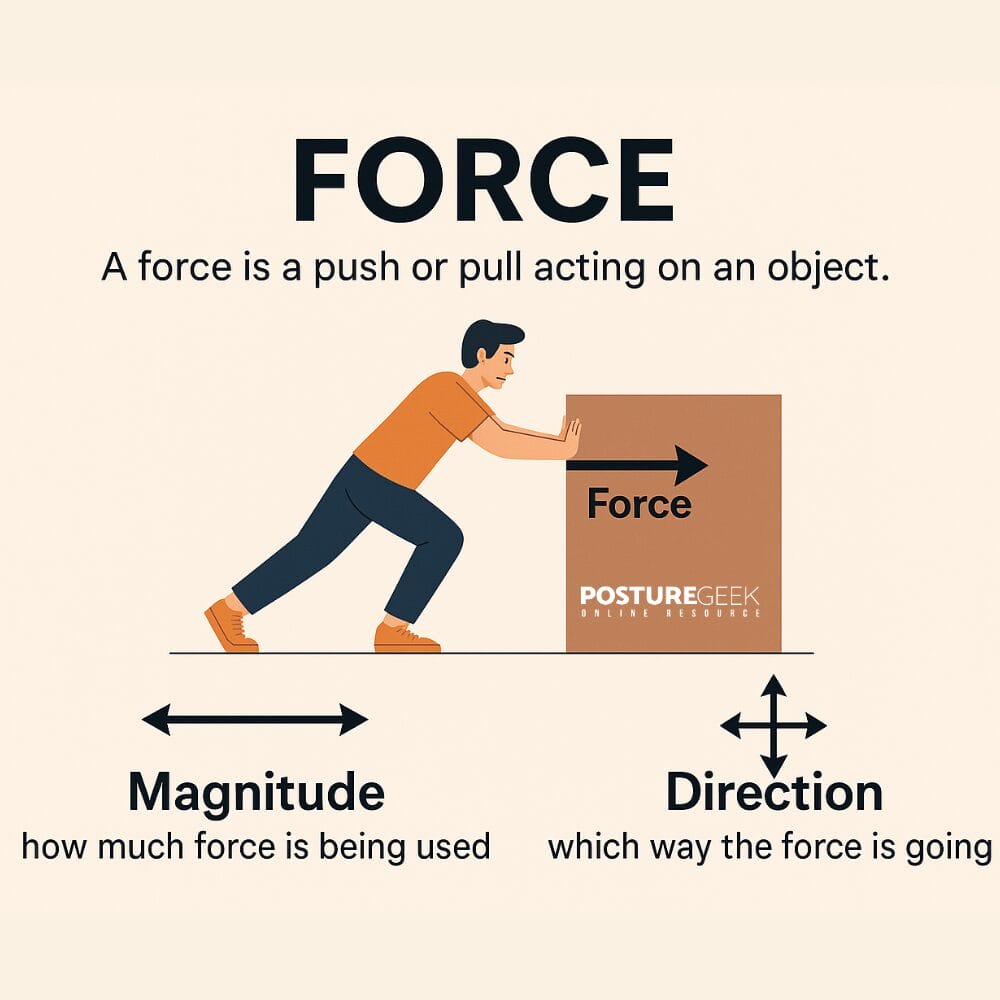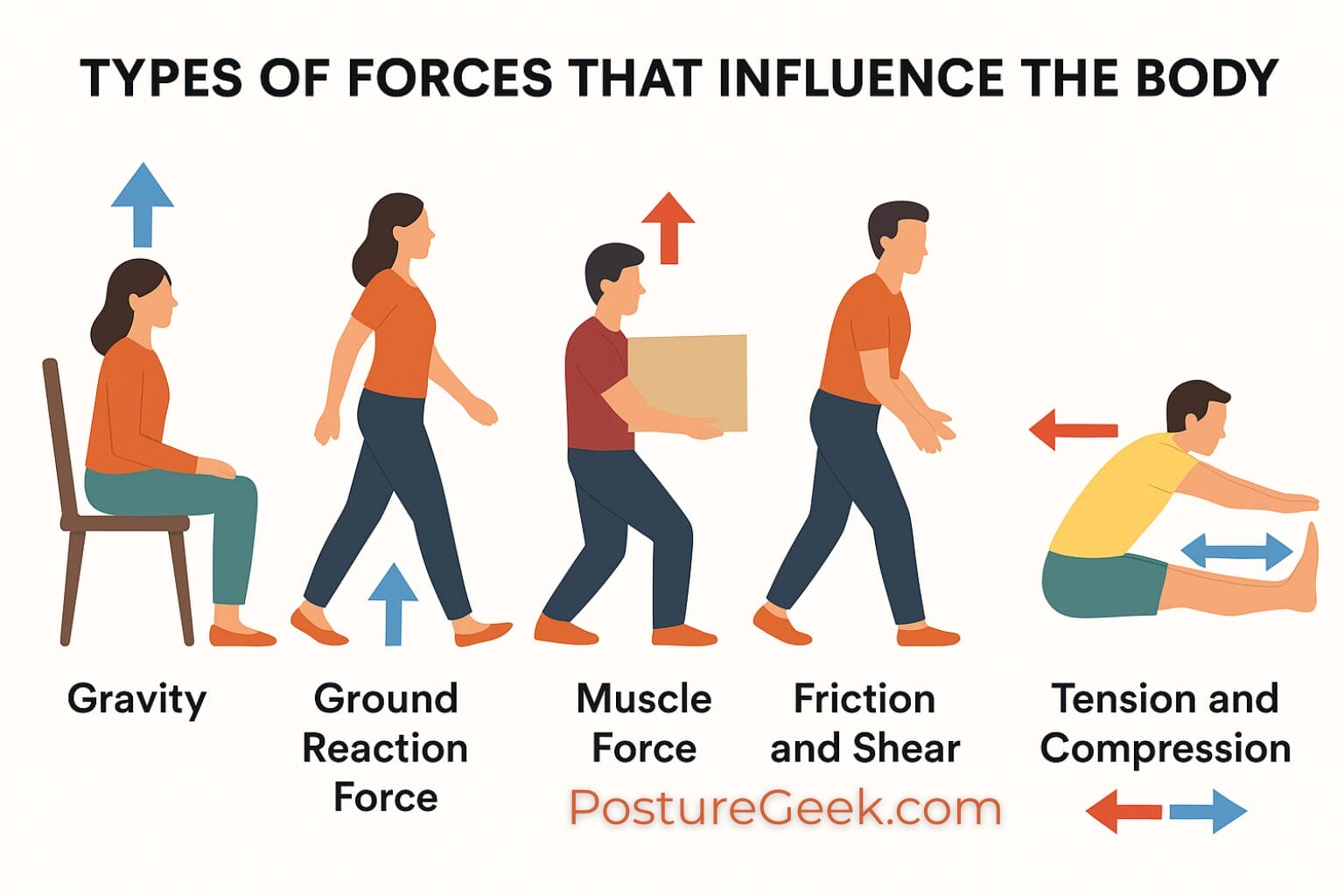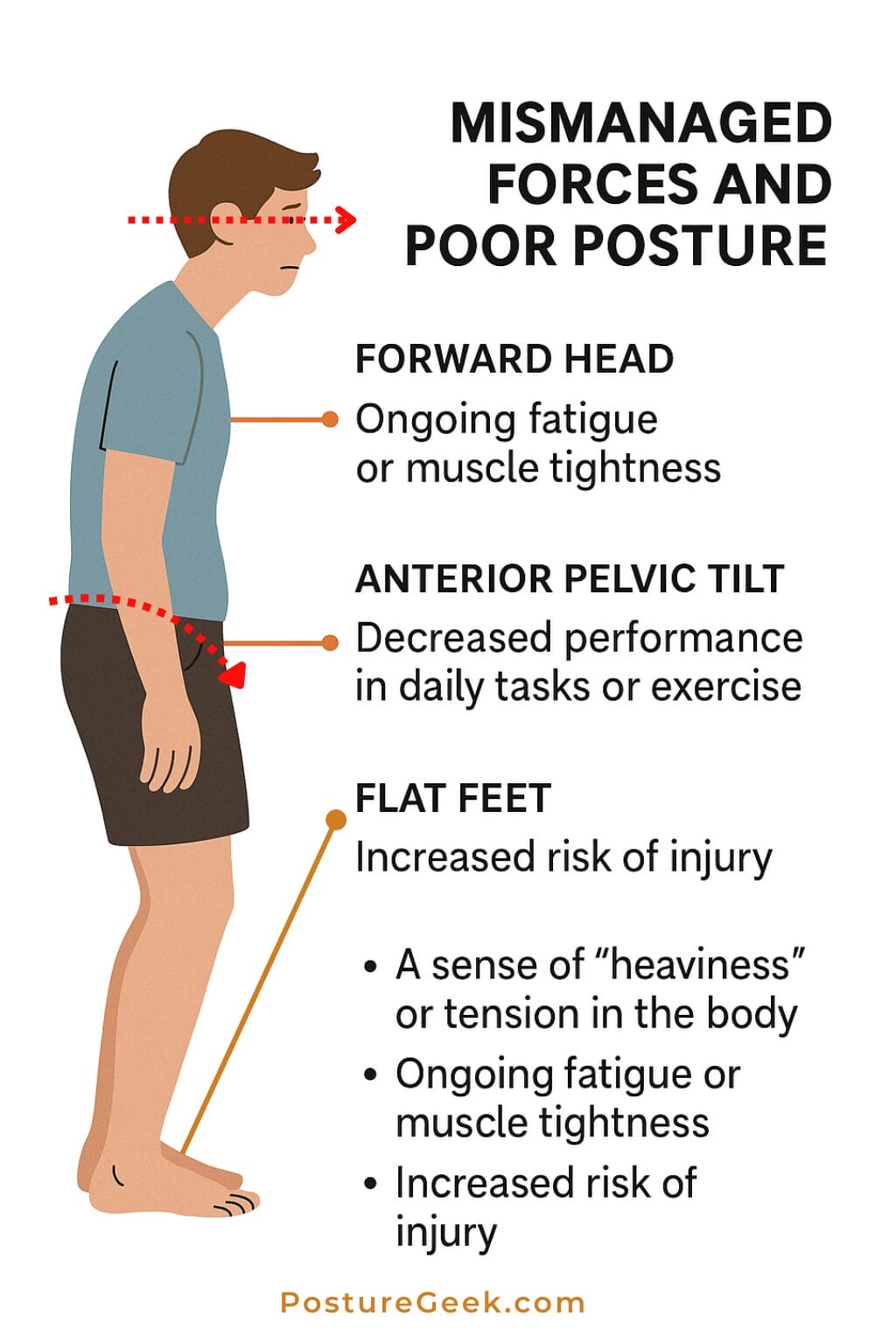- Updated - November 10, 2025
Understanding Force in the Human Body: The Hidden Driver Behind Posture and Movement
When we talk about posture and movement, we’re really talking about how the body interacts with forces: gravity, ground reaction, muscular tension, and the elastic pull of fascia. These aren’t abstract physics concepts; they’re the invisible exchanges that shape how we stand, move, and respond to the world around us.
Every time you sit, reach, or walk, your body is negotiating with these forces. They determine how efficiently you transfer load through your structure, how you balance under gravity, and how your tissues adapt to daily demand. The better your body manages force, the more balanced, coordinated, and resilient you feel.
For practitioners, understanding force provides a biomechanical lens for interpreting posture and movement patterns. It reveals where the body is working too hard, where it’s collapsing, and how mechanical stress travels through the kinetic chain. For everyone else, it offers a clearer sense of why certain positions or habits feel tiring — and how small shifts in awareness can transform stability and ease.
What Is a Force in the Context of the Human Body?

In the body, a force isn’t an abstract equation; it’s a lived experience. Every moment you move, sit, or breathe, your body applies, absorbs, and redirects forces. These interactions shape how efficiently you stand, how fluidly you move, and how well your structure adapts to daily load.
From a biomechanical perspective, force is simply the energy of interaction between your body and its environment. When your feet meet the ground, when muscles contract to stabilize a joint, or when gravity pulls you downward, forces are at work, guiding alignment, influencing tension, and shaping posture.
Force in this context has both:
- magnitude (how much effort or load is involved) and,
- direction (where that effort travels through the body).
When these two align efficiently, movement feels light and supported. When they don’t, tissues strain, posture compensates, and inefficiency builds over time.
In biomechanics, you might still see the classic equation:
- F = m × a (Force = mass × acceleration), but its meaning changes.
It’s not about calculating movement; it’s about understanding how the body distributes effort and maintains equilibrium. When you lift, lean, or stabilize, the nervous system continuously modulates how much force to generate and where to send it.
Seen this way, force isn’t just a number. It’s the underlying dialogue between the body, gravity, and ground, the constant negotiation that allows you to move without collapsing and stand without fatigue.
Types of Forces That Influence the Body

Our bodies constantly interact with different forces, whether walking, stretching, reaching for something on a shelf, or standing still. These forces shape how we move, hold ourselves, and even feel at the end of the day.
When we understand the forces at play, we can make smarter choices that support healthier posture and easier, more confident movement. This awareness can make us more conscious of our body mechanics and how we can improve them.
Let’s look at some of the most common forces your body deals with daily — and how they affect posture and movement.
Discover a practitioner near you.
Looking for a practitioner near you? Our extensive network of qualified professionals is here to help you.
1. Gravity
Gravity is the constant downward pull from the Earth. It’s always there, whether we notice it or not.
- When you stand or sit, gravity pulls your body toward the ground.
- To stay upright, your body has to work against this pull.
- If you slouch or lean, gravity starts pulling more on some parts than others, which can lead to strain and tension over time.
2. Ground Reaction Force
Every time you step, jump, or shift your weight, the ground pushes back. This push is called the ground reaction force.
- Think of it as your body’s silent dance partner — what you give to the ground, it gives back.
- Your muscles and joints take in and respond to that force. This is why foot posture and alignment matter — they help your body manage this invisible but powerful exchange.
- If your posture or alignment is off, your body might not absorb this force well, which can lead to joint pain, balance issues, or tiredness.
3. Muscle Force
Muscles create a force to move us or keep us stable. This happens in different ways:
- Holding still: Like balancing in a yoga pose.
- Lifting: When the muscle shortens to pick something up.
- Lowering: When the muscle slowly lengthens, like putting a box down carefully.
Strong, well-coordinated muscles are essential for holding good posture and moving well throughout the day.
4. Friction and Shear
These forces happen when two surfaces slide against each other.
- Friction helps — like when your shoes grip the floor and stop you from slipping.
- Shear can be tricky — too much rubbing, like skin against a hard seat, can cause irritation or stress on joints.
With good posture and movement habits, we can avoid the unhelpful side of these forces.
5. Tension and Compression
These are the forces that either pull or press on parts of your body.
- Tension is the gentle pull you feel during a stretch — it’s happening in muscles, tendons, and connective tissue.
- Compression is what your joints feel when you stand or carry something — it’s pressure pushing inward.
A healthy balance between these two helps our joints work well and prevents discomfort or injury.
These forces are always in play, even if we’re not aware of them. The more we learn to work with them — through better awareness, posture, and movement — the better our bodies feel and function.
Force and Posture: A Functional Relationship

Posture isn’t just about standing up straight or looking confident. It’s about how your body responds to and manages the forces acting on it throughout the day. Whether walking, sitting, reaching, or resting, your posture reflects how well your body handles gravity, muscle tension, and any loads you might be carrying (like a bag or a toddler!).
Good posture helps distribute these forces evenly so that no one part of your body takes on more strain than it can handle. It’s not about being rigid or perfectly upright — it’s about being adaptable, balanced, and efficient.
What Happens When Forces Are Mismanaged?
When the body isn’t managing forces well, it starts to compensate. These compensations may feel normal at first, but over time, they can create patterns that wear the body down or make movement more difficult.
Here are a few common examples:
- Forward head posture: This happens when the head juts forward in front of the shoulders. It might seem like a small thing, but it adds extra weight and pressure on the neck and upper back, which can lead to soreness, stiffness, or even headaches.
- Anterior pelvic tilt: When the pelvis tips forward, it puts more stress on the lower back and can make your belly stick out. This posture often comes from long periods of sitting or weak core muscles and can affect how you walk, stand, and even breathe.
- Flat feet: If your arches collapse when you stand or walk, it affects how your body absorbs impact. Without proper support at the base, the knees, hips, and back may have to compensate, leading to discomfort or inefficient movement patterns.
Over time, these imbalances can lead to:
- Ongoing fatigue or muscle tightness
- Decreased performance in daily tasks or exercise
- Increased risk of injury
- A sense of “heaviness” or tension in the body
The good news? Small changes in awareness, movement habits, and alignment can significantly affect how your body feels and functions each day.

Practitioners: Thinking in Terms of Force
For practitioners, the concept of force offers a powerful lens through which to assess and improve posture and movement. Rather than focusing solely on the structure or isolated symptoms, clinicians can evaluate how well the body manages internal and external loads in real time.
Every client interaction becomes an opportunity to explore how force is generated, absorbed, transferred, or dissipated. A force-based framework allows for greater clinical precision when identifying inefficiencies or stress points within the kinetic chain.
Key clinical considerations include:
- Muscular force production: Can specific muscle groups generate sufficient force to support, stabilize, or initiate movement? Consider testing under dynamic and isometric conditions to detect functional weakness or compensation.
- Joint alignment and force transmission: Are bony structures aligned to allow force to pass efficiently through the system? Misalignments can create bottlenecks, overload adjacent structures, or reduce mechanical leverage.
- Fascial integrity and tension patterns: Is the fascial network distributing tensile loads appropriately? Fascial restrictions or imbalances often distort force pathways and lead to chronic overuse or underuse of certain regions.
- Neuromuscular coordination and timing: Is the nervous system sequencing muscle activation in a way that supports fluid, force-efficient movement? Faulty motor control often underlies inefficient or energy-wasting movement strategies.
Clinical strategies for optimizing force use may include:
- Neuromuscular re-education to improve motor patterning
- Manual techniques to restore fascial glide and length-tension balance
- Strength and stability training focused on functional force generation
- Movement retraining to support load transfer through postural alignment
Integrating force as a clinical lens allows practitioners to treat beyond symptoms, restoring balance, ease, and adaptability in the client’s system. This approach encourages practitioners to see posture not as a fixed position but as an ongoing, force-mediated negotiation with the environment.
Practical Tips for Individuals and Practitioners
Understanding force doesn’t require a physics background — just some curiosity and body awareness. Whether you’re a practitioner working with clients or someone looking to improve how you move through your daily activities, these tips can help you apply force-based principles for better posture, strength, and balance.
For Everyone:
- Feel the ground beneath you: Whether you’re sitting in a chair or standing in line, take a moment to notice the points of contact — your feet on the ground, your seat in the chair, or your back against a surface. Are those contact points evenly loaded, or is there more pressure on one side? Balanced contact helps distribute force more efficiently.
- Use breath as a stabilizer: Your breath can do more than keep you alive — it can also help stabilize your core. Try breathing into your ribcage and abdomen, expanding in all directions. This intra-abdominal pressure provides a natural support system for your spine and helps manage internal forces.
- Align before you move: Before you pick something up, twist, or even stand from a chair, pause for a second to reset your alignment. A neutral spine, balanced pelvis, and engaged core allow your body to manage movement forces with greater ease and safety.
- Strengthen with intention: Don’t just focus on lifting heavier or doing more reps. Instead, think about where the force is coming from and where it’s going. Engage the right muscles, use full-body coordination, and build awareness. Strength developed this way is not only more functional — it’s more protective.
- Minimize resistance and tension: Sometimes the biggest barrier to easy movement is our unconscious tension. Check in with your jaw, shoulders, or hands — are they clenching or gripping unnecessarily? Let go of what’s not needed. Efficient movement often comes from doing less, not more.
For Practitioners:
- Encourage clients to become curious about how force feels in their bodies.
- Use these concepts to create more effective cueing during sessions (e.g., “Feel your weight shift evenly through your feet,” or “Notice how your breath supports your posture”).
- Integrate force awareness into warm-ups, movement prep, and even hands-on techniques. Every moment is an opportunity to improve force literacy.
When individuals become more aware of how force travels through their bodies, they move better, feel stronger, and become less prone to fatigue or injury. And when practitioners model and reinforce that awareness, the results can be transformative.
The Takeaway: Force Is the Language of the Body
Every time you move, hold, push, or resist, you speak the language of force. It’s happening whether you’re lifting groceries, shifting in your seat, performing a manual therapy technique, or coaching someone through a movement pattern. Force is not just for athletes or physics classes — it’s the everyday currency your body uses to interact with the world. Even standing in line, unloading groceries, or reaching into a cupboard involves constant micro-adjustments to manage force efficiently and avoid strain.
For the general public, tuning into how force flows through the body helps with posture, reduces unnecessary tension, and enhances confidence in movement. It leads to more balanced effort, fewer aches, and better energy throughout the day.
For practitioners, this lens deepens clinical reasoning and enhances results. It helps you recognize how and where forces are being mishandled, redirected, or misunderstood in your clients’ systems. Whether you’re assessing movement patterns, applying manual techniques, or cueing breath and stability, every intervention becomes more intentional when viewed through the lens of force.
Understanding force offers a unifying principle that bridges posture, performance, and well-being. It’s a language worth learning — and listening to — in every body.
Next time you stand tall, sit upright or lift an object, ask yourself:
How is a force flowing through me? Am I allowing it to support me — or am I working against it?
Want to dive deeper? Subscribe to PostureGeek for ongoing insights into posture, movement, and body mechanics that make a difference.
Resources
Articles:
Gravity and Posture:
Gravity, Posture, and Cardiopulmonary Function
This article examines how changes in body position relative to gravity can alter cardiopulmonary function, emphasizing the importance of posture in managing gravitational effects
Ground Reaction Forces:
The ‘Postural Rhythm’ of the Ground Reaction Force during Upright Standing
This study investigates how ground reaction forces are modulated by sensory conditions and their relationship with body sway during upright standing.
PLEASE NOTE
PostureGeek.com does not provide medical advice. This information is for educational purposes only and is not intended to be a substitute for professional medical attention. The information provided should not replace the advice and expertise of an accredited health care provider. Any inquiry into your care and any potential impact on your health and wellbeing should be directed to your health care provider. All information is for educational purposes only and is not intended to be a substitute for professional medical care or treatment.
About the author
Join our conversation online and stay updated with our latest articles.
Find Expert Posture Practitioner Near You
Discover our Posture Focused Practitioner Directory, tailored to connect you with local experts committed to Improving Balance, Reducing Pain, and Enhancing Mobility.
